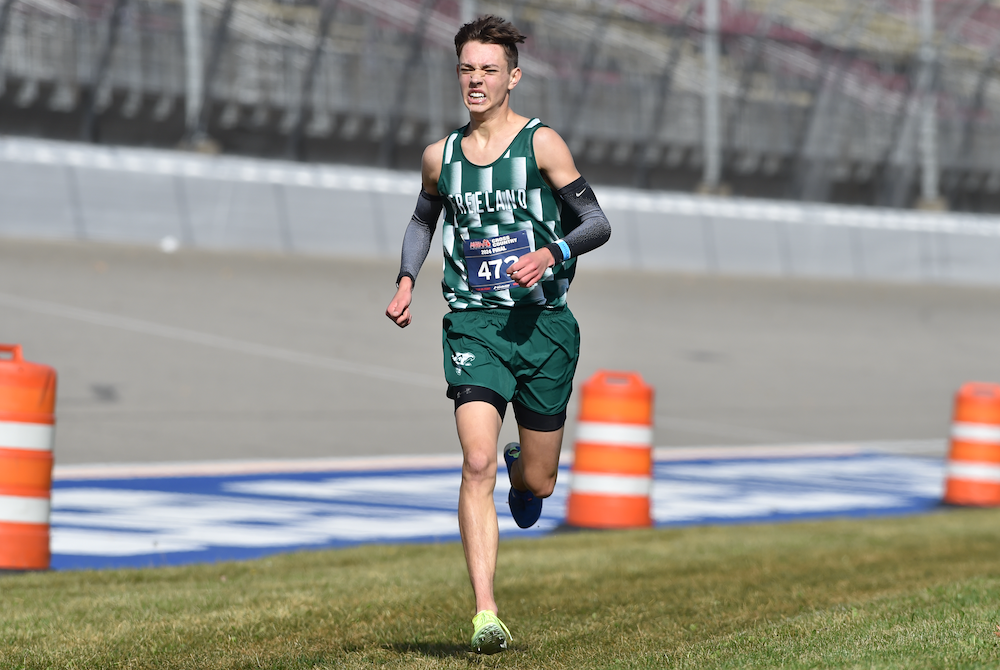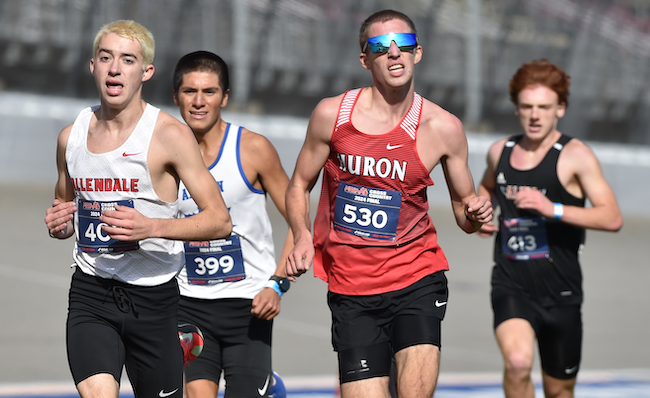
Hansen Goes Distance Again, Allendale Claims 1st Final Since 1999
November 2, 2024
BROOKLYN — It looked like TJ Hansen of Freeland had gotten a big head start on the rest of the field, not that he needed it.
Hansen, after all, set the MHSAA Lower Peninsula Division 2 Finals record with his time of 14 minutes, 52.8 seconds last year.
But here he was, moments before the start of Saturday’s Division 2 race at Michigan International Speedway, nearly in a dead sprint 600 yards from the start rushing into the Freeland tent to quickly change his shorts.
The style of shorts Hansen was wearing differed from those of his teammates, a uniform violation that would have disqualified the reigning champion. After frantically rushing to get different shorts, Hansen was put in a cart and rushed to the start line.
There was no time to decompress.
“As soon as I got back, it was 10 seconds and, boom, the gun went off,” he said. “It’s just a lesson in dealing with adversity.”
For a few highly-stressful minutes, Hansen feared he would be on the sideline while someone else won a championship he was out to defend.
 “It kind of flashes before your eyes,” he said. “They tell you you’re DQ’d, and all those months of hard work seem like they flash before your eyes and all go to waste.”
“It kind of flashes before your eyes,” he said. “They tell you you’re DQ’d, and all those months of hard work seem like they flash before your eyes and all go to waste.”
When the gun went off, Hansen was back in his element and repeated as champion by lowering his Division 2 record to 14:50.5, the fourth-fastest time in any division at MIS.
He needed every bit of that effort, as Marshall senior Jack Bidwell took second in 14:57.3, a time that is the third-fastest by a Division 2 runner and 14th all-time in any division.
Hansen and Bidwell reached the two-mile mark together in 9:36.2 before the defending champion pulled away in the final mile.
“It was really just try to push the pace and see how fast I could go,” Hansen said. “My legs weren’t really feeling it today, so I changed up strategy to race to win.”
Hansen won 11 of 12 races this year, losing only to a runner from Tennessee on Oct. 5 in Indiana.
In the team race, Allendale won its first MHSAA Finals championship since 1999 by placing its five scoring runners among the top 29. The top 30 made all-state. The Falcons scored 78 points to win by 102 over 2023 champion Ada Forest Hills Eastern.
Sophomore Mason Hill was ninth in 15:24.0, senior Kilian Whalen 13th in 15:28.8, junior Ronnie Silveira 15th in 15:31.1, senior Ben Gross 27th in 15:47.1 and senior Parker Tiethof 29th in 15:48.3.
Allendale was fourth last year and returned its top six runners.
PHOTOS (Top) Freeland’s TJ Hansen pushes to the finish line in the Division 2 race Saturday after looking back to see Marshall’s Jack Bidwell also on the home stretch. (Middle) Allendale’s Mason Hill (403) and New Boston Huron’s Lucas Kuhn (530) race among the lead packs. (Click for more from Dave McCauley/RunMichigan.com.)

MHSAA Vault: MIS Rose to Challenges to Host 2020 LP Finals
By
Rob Kaminski
MHSAA benchmarks editor
November 12, 2021
The “MHSAA Vault” features stories from past publications and other documents in the MHSAA Library. This issue takes a look at the MHSAA Cross Country Finals at Michigan International Speedway, which celebrated 25 years in 2020 – although it was an event that nearly didn’t happen last fall …
In 1996, the MHSAA and Michigan International Speedway began a partnership the changed the course of the Lower Peninsula Cross Country Finals – quite literally.
The land in and around the track at Brooklyn would host the Finals for all classes of runners in one place on one day, an annual festival of nearly 2,000 runners competing for the MHSAA’s top honors.
Even skeptics – and there were several among running purists who thought the course was too flat, for example – can’t deny the results.
Finals attendance nearly doubled in that first year, and crowds in excess of 10,000 have enjoyed a day of racing several times, including a record 12,153 in 2011.
Enthusiastic crowds were the norm in recent years, with 11,232 in 2017, and nearly 11,000 in 2018 (10,989) and 2019 (10,873).
In fact, attendance failed to reach at least 8,000 only twice since the move to MIS.
Of course, last year was an exception, when attendance was limited to 1,000 spectators per session due to the COVID-19 Pandemic. Fans also were restricted to the grandstands rather than following the action throughout locations on the course.
To reduce the number of runners in each race, the event was spread over two days, with each Division being run in two separate “sections” with times then combined at the end to determine team and individual champions.
While not ideal, the end result was another year of fantastic efforts at MIS – both from student-athletes and those behind the scenes.
“Even at the last hour, less than a week ahead of the Finals, we were closer to not having the Finals than we were to having them,” said MHSAA Assistant Director Cody Inglis, who coordinates the cross country postseason. “Rumors and challenges of mandated shutdowns, testing and other requirements were being discussed and caused a lot of unknowns. Even at the Regional level, we had schools, Regional courses and hosts shutting down their facilities; we had to relocate four Regionals 48 hours prior to race times. That scenario just could not happen at the Finals level where far more runners and much more travel would be involved.”
Among the many last-minute hurdles was the edict from NASCAR – which owns MIS – that all persons on site be temperature checked upon entry. That meant securing thermometers that were easy to operate in short order, along with personnel necessary to conduct the readings.
The attendance limitations certainly helped to implement the temperature screening, but brought their own issues.
“Limiting spectators was not a popular decision, but it really was the only way to have a race,” Inglis said. “We were taking direction and working with policies and protocols from the MDHHS, the Governor’s office, Lenawee County Health Department, MIS and NASCAR.”
Part of the solution was to utilize the grandstands as a “barrier” between participants and spectators. The reduced number of fans were dispersed over thousands of seats while still allowing them the chance to watch their student-athletes compete.
“It wasn’t the same, it wasn’t easy or perfect, but it was what we had to do to have a race,” Inglis said. “Separating the Finals into two days and different sections also allowed us to spread out the event and limit the number of people on site at any one time. This was a key part of the plan and worked well even though it separated races within a Division.”
The MHSAA, MIS and the cross country community never lost focus of the main goal: a culmination of the season for the student-athletes, who deserved something last year more than ever. And, more than ever, MIS once again displayed its advantage as a venue that could adapt to the fluid nature of the times to pull off the event.
“There were some thoughts of using four different sites, but as we learned during the Regionals, the climate of things was so tenuous from one area of the state to another that we couldn’t be 100-percent certain that there wouldn’t again be last-minute cancelations,” Inglis said. “MIS was wonderful to work and collaborate with, and was the best option to get it done. It was never mentioned once publicly about the possibility of not having the Finals – only how we could best do it under uncharted conditions.”
The moving parts and ever-changing scenarios created more complexity than ever in finalizing a season, but every decision was made with the complete desire to conduct the Finals as close to normal as possible.
“I firmly believe that a finish to the season, no matter the differences in race formatting and fan experience, was something everyone would have taken when the season began in August,” Inglis said.
Indeed, the finish line in Year 25 at MIS might have been the most gratifying of them all.

